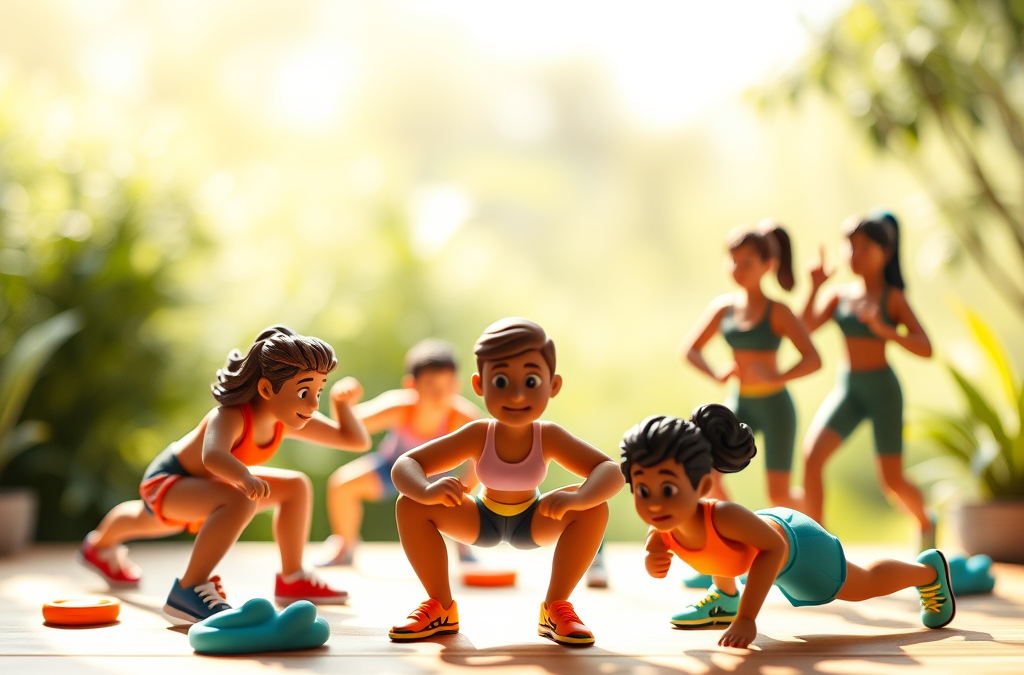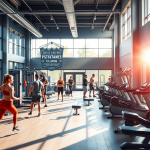Starting a fitness journey can feel overwhelming, especially if you’re new to exercise or don’t have access to a gym. The good news? You don’t need fancy equipment or a membership to get moving. With just your body weight and a little space, you can build strength, improve endurance, and boost your mood from the comfort of your home. This article outlines 10 beginner-friendly exercises you can start today, no gym required. Each exercise is simple, effective, and backed by science to help you kickstart your fitness journey. Let’s dive in!
Why Start With Bodyweight Exercises?
Bodyweight exercises are perfect for beginners because they require no equipment, can be done anywhere, and are highly adaptable to different fitness levels. According to a 2018 study published in the Journal of Strength and Conditioning Research, bodyweight training can improve muscular strength, endurance, and cardiovascular health, making it an excellent starting point for fitness newbies (Calatayud et al., 2018). Plus, these exercises teach proper movement patterns, reducing the risk of injury as you progress.
Below, we’ll cover 10 exercises, how to do them, and their benefits. Each one targets key muscle groups and can be modified to suit your current fitness level. Let’s get moving!
10 Beginner-Friendly Bodyweight Exercises
1. Bodyweight Squats
Muscles Worked: Quads, hamstrings, glutes, core
Squats are a foundational movement that mimics everyday activities like sitting and standing. They build lower body strength and improve mobility.
How to Do It:
- Stand with feet shoulder-width apart, toes slightly turned out.
- Lower your hips as if sitting into a chair, keeping your chest up and knees tracking over your toes.
- Push through your heels to return to standing.
- Do 3 sets of 10-15 reps.
Beginner Tip: If balance is an issue, hold onto a sturdy surface like a countertop.
Benefits: A 2020 study in Sports Medicine found that squats enhance lower body power and functional movement, crucial for daily activities (Kubo et al., 2020).
2. Push-Ups (Modified or Standard)
Muscles Worked: Chest, shoulders, triceps, core
Push-ups are a classic upper-body exercise that also engage your core for stability.
How to Do It:
- Start in a plank position with hands slightly wider than shoulders.
- For modified push-ups, place your knees on the ground.
- Lower your chest toward the floor, keeping elbows at a 45-degree angle.
- Push back up to the starting position.
- Aim for 3 sets of 8-12 reps.
Beginner Tip: Wall push-ups are a great starting point if floor push-ups feel too hard.
Benefits: Push-ups improve upper body strength and core stability, as noted in a 2019 study in Frontiers in Physiology (Yang et al., 2019).
3. Plank Hold
Muscles Worked: Core, shoulders, back
The plank is a fantastic exercise for building core strength and improving posture.
How to Do It:
- Lie face down, then prop yourself up on your forearms and toes, keeping your body in a straight line.
- Engage your core by pulling your belly button toward your spine.
- Hold for 15-30 seconds, gradually increasing time as you get stronger.
- Do 3 sets.
Beginner Tip: Drop to your knees for a modified plank.
Benefits: Planks enhance core stability, which reduces lower back pain, according to a 2021 study in Physical Therapy (Hodges et al., 2021).
4. Glute Bridges
Muscles Worked: Glutes, hamstrings, lower back
Glute bridges strengthen your posterior chain, which is key for hip stability and reducing lower back strain.
How to Do It:
- Lie on your back with knees bent and feet flat, hip-width apart.
- Push through your heels to lift your hips until your body forms a straight line from shoulders to knees.
- Squeeze your glutes at the top, then lower slowly.
- Perform 3 sets of 12-15 reps.
Beginner Tip: Focus on slow, controlled movements to avoid arching your back.
Benefits: A 2017 study in Journal of Physical Therapy Science showed glute bridges improve hip strength and reduce injury risk (Lehecka et al., 2017).
5. Incline or Wall Push-Ups
Muscles Worked: Chest, shoulders, triceps
Incline push-ups are a gentler alternative to standard push-ups, ideal for beginners.
How to Do It:
- Place your hands on a sturdy surface like a table or wall, slightly wider than shoulder-width.
- Step back so your body forms a straight line.
- Lower your chest toward the surface, then push back up.
- Do 3 sets of 10-12 reps.
Beginner Tip: The higher the surface, the easier the exercise.
Benefits: Incline push-ups build upper body strength with less intensity, as supported by a 2018 study in Journal of Strength and Conditioning Research (Calatayud et al., 2018).
6. Step-Ups
Muscles Worked: Quads, glutes, hamstrings
Step-ups mimic climbing stairs and are great for building leg strength and coordination.
How to Do It:
- Find a sturdy step or low bench.
- Step up with one foot, pushing through your heel to lift your body.
- Step down slowly and repeat with the other leg.
- Do 3 sets of 10 reps per leg.
Beginner Tip: Hold onto a railing for balance if needed.
Benefits: Step-ups improve single-leg strength and balance, as noted in a 2019 study in Sports Biomechanics (McNally et al., 2019).
7. Wall Sits
Muscles Worked: Quads, glutes, core
Wall sits are an isometric exercise that builds endurance in your lower body.
How to Do It:
- Lean against a wall with feet about 2 feet away.
- Slide down until your thighs are parallel to the ground, knees at 90 degrees.
- Hold for 20-30 seconds, working up to 60 seconds.
- Do 3 sets.
Beginner Tip: Start with a higher position if a deep sit is too challenging.
Benefits: Isometric exercises like wall sits improve muscle endurance, per a 2020 study in Journal of Applied Physiology (Schoenfeld et al., 2020).
8. Bird Dogs
Muscles Worked: Core, back, glutes
Bird dogs improve balance and core stability while being gentle on the spine.
How to Do It:
- Start on all fours, hands under shoulders and knees under hips.
- Extend your right arm and left leg simultaneously, keeping your body stable.
- Hold for 2-3 seconds, then switch sides.
- Do 3 sets of 10 reps per side.
Beginner Tip: Move one limb at a time if coordination is tricky.
Benefits: Bird dogs enhance spinal stability, as shown in a 2018 study in Journal of Back and Musculoskeletal Rehabilitation (Huxel Bliven et al., 2018).
9. Standing Calf Raises
Muscles Worked: Calves
Calf raises strengthen the lower legs, improving ankle stability and walking efficiency.
How to Do It:
- Stand with feet hip-width apart, near a wall for balance if needed.
- Rise onto your toes, lifting your heels as high as possible.
- Lower slowly back down.
- Do 3 sets of 15-20 reps.
Beginner Tip: Perform single-leg calf raises as you progress.
Benefits: Strong calves support better mobility, per a 2019 study in Gait & Posture (Hébert-Losier et al., 2019).
10. Seated Leg Lifts
Muscles Worked: Quads, core
Seated leg lifts are a low-impact way to strengthen your thighs and core.
How to Do It:
- Sit on a sturdy chair with your back straight.
- Extend one leg straight out, keeping the other foot flat on the ground.
- Hold for 2-3 seconds, then lower slowly.
- Do 3 sets of 12 reps per leg.
Beginner Tip: Keep movements small if you feel unsteady.
Benefits: Leg lifts improve quad strength, which supports knee health, as noted in a 2021 study in Clinical Biomechanics (Rathleff et al., 2021).
Creating a Beginner Workout Routine
To get started, combine these exercises into a 20-30 minute workout, 3-4 times per week. Here’s a sample routine:
- Warm-Up (5 minutes): March in place, arm circles, and gentle stretches.
- Circuit: Do 1 set of each exercise (e.g., 12 squats, 10 push-ups, 20-second plank, etc.), moving from one to the next with minimal rest.
- Repeat: Complete 2-3 rounds, resting 1-2 minutes between rounds.
- Cool-Down (5 minutes): Stretch your quads, hamstrings, and shoulders.
As you get stronger, increase reps, sets, or hold times. Listen to your body and progress gradually to avoid burnout or injury.
Tips for Success
- Stay Consistent: Aim for 3-4 workouts per week. Consistency is key, per a 2020 study in Medicine & Science in Sports & Exercise (Warburton et al., 2020).
- Focus on Form: Proper technique prevents injury and maximizes results.
- Hydrate and Rest: Drink water and prioritize sleep to support recovery.
- Track Progress: Note how many reps or seconds you can do to stay motivated.
Conclusion
Starting a fitness journey doesn’t require a gym or fancy gear. These 10 bodyweight exercises—squats, push-ups, planks, and more—offer a solid foundation for building strength, endurance, and confidence. Backed by research, they’re safe, effective, and adaptable for beginners. Start small, stay consistent, and watch your progress soar.
Ready to move? Pick a few exercises and get started today!
Sources:
- Calatayud, J., et al. (2018). Journal of Strength and Conditioning Research.
- Kubo, K., et al. (2020). Sports Medicine.
- Yang, J., et al. (2019). Frontiers in Physiology.
- Hodges, P. W., et al. (2021). Physical Therapy.
- Lehecka, B. J., et al. (2017). Journal of Physical Therapy Science.
- McNally, M., et al. (2019). Sports Biomechanics.
- Schoenfeld, B. J., et al. (2020). Journal of Applied Physiology.
- Huxel Bliven, K. C., et al. (2018). Journal of Back and Musculoskeletal Rehabilitation.
- Hébert-Losier, K., et al. (2019). Gait & Posture.
- Rathleff, M. S., et al. (2021). Clinical Biomechanics.
- Warburton, D. E., et al. (2020). Medicine & Science in Sports & Exercise.






